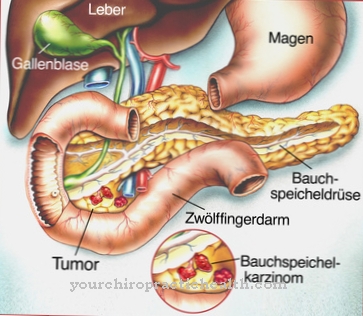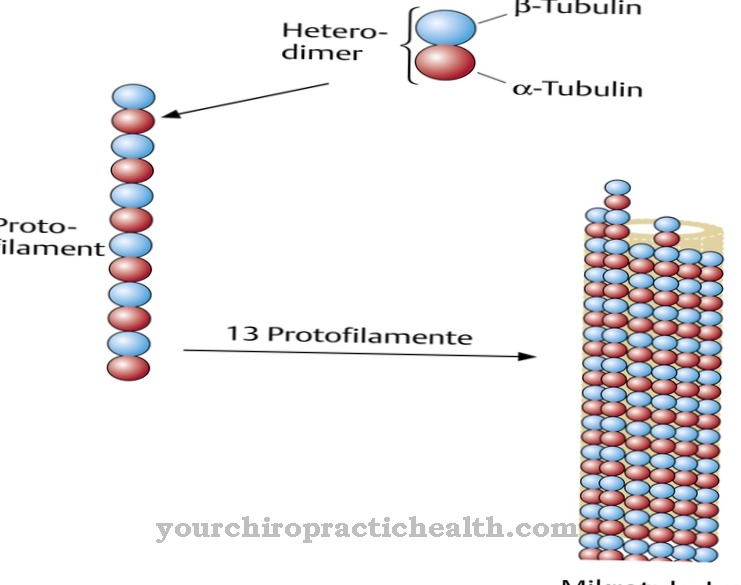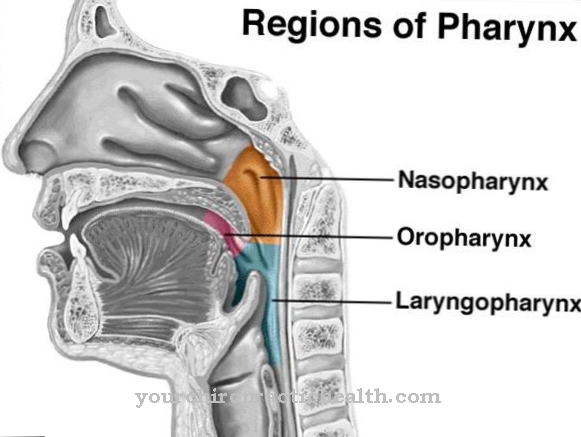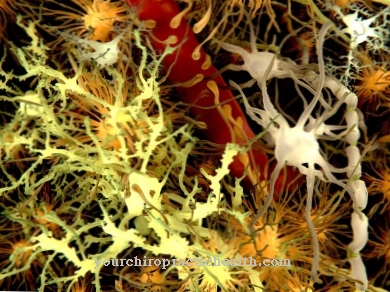At the Rhombencephalon it is a structure in the brain made up of an elongated medulla and hindbrain. Its functions include the control of various reflexes, the regulation of vomiting, breathing and blood circulation as well as motor processes. Diseases and disorders affect the various functional centers and can be due to lesions, neurological diseases and especially the rhombencephalosynapsis.
What is the rhombencephalon?
The rhombencephalon is part of the brain and is also known under the common name "Hindbrain" known. Both the elongated spinal cord (medulla oblongata) and the hindbrain (metencephalon) or 4th cerebral vesicle belong to this part of the central nervous system. The rhombencephalon maintains close connections to the spinal cord and cerebrum as well as to the cerebral ventricles.
These cavities are located within the brain tissue and contain fluid (liquor); medicine therefore also combines the ventricles to form the internal liquor space. In addition, the rhombencephalon is connected to the external liquor space, which is located between two meninges (arachnoid mater and pia mater). The name of the rhombencephalon comes from the diamond pit that lies on the Pons.
Anatomy & structure
Within the rhombencephalon, doctors differentiate between two larger anatomical structures: the elongated spinal cord (medulla oblongata) and the hindbrain (metencephalon). The medulla oblongata is not sharply delimited from the spinal cord; this applies to both its anatomy and its functions, which are very similar to those of the spinal cord.
Complex neural networks in the medulla oblongata form functional centers such as the vomiting and breathing centers. Macroscopically, however, they can hardly be distinguished from the rest of the tissue. However, various nuclei and the central canal, which protrudes downward from the elongated pith like a tube, are clearly recognizable. The central canal descends from the neural tube.
The metencephalon or hindbrain, which also belongs to the rhombencephalon, consists of the cerebellum (cerebellum) and the bridge (pons). The cerebellum has its own cortex with three layers; In each layer there are certain types of nerve cells. Under the cortex, in the interior or medulla of the cerebellum, there is mostly white matter. This consists of the isolated axons of the neurons and is of great importance for interconnection and information processing.
Nuclei in the medulla of the cerebellum each form distinct structures with specific tasks. Also in the pons, the other part of the metencephalon, are core areas - including the nucleus motorius nervi trigemini, the nucleus nervi abducentis and the nucleus motorius nervi facialis. Nerve tracts run through the pons and connect the brain to the rest of the human body.
Function & tasks
The different parts of the rhombencephalon each perform their own tasks; In summary, the main task of the hindbrain is the control of involuntary motor processes.
The medulla oblongata connects the spinal cord with other parts of the rhombencephalon and carries nerve signals out and to most parts of the body. Functional networks of nerve cells in the elongated marrow form the respiratory center, which controls all involuntary types of breathing, and the vomiting center, which triggers vomiting in response to signals from the digestive tract, the equilibrium organ or the chemical receptors of the area postrema. The medulla oblongata is also home to interconnections for reflexes for choking, coughing, sneezing, swallowing and sucking (in babies). The main task of the Pons is to pass on information. The motor nerve nuclei of the bridge form a place of origin for cranial nerves.
The functions of the cerebellum, which houses half of all nerve cells in the brain, are particularly extensive. The tasks of the cerebellum range from motor processes and learning processes to contributions to higher cognitive functions. The cerebrocerebellum is primarily responsible for the latter; In this way, the rhombencephalon helps plan movements in advance. The motor control of the cerebellum contributes to speaking and coordinates the holding and supporting motor skills as well as the movements when walking and standing.
You can find your medication here
➔ Medicines against memory disorders and forgetfulnessDiseases
The rhombencephalosynapsis is a very specific clinical picture of the rhombencephalon; the disease rarely occurs. The basis is a malformation in the cerebellum. In a healthy person, this part of the rhombencephalon consists of two halves, but in the rhombencephalosynapsis they are fused together.
This condition affects the various anatomical and functional structures of the cerebellum. Patients are often mentally retarded and suffer from a number of distinctive disorders. One of them is ataxia, i. H. the disorder of movement coordination. As a gait ataxia, it can also be a consequence of lesions in the rhombencephalon and other areas of the brain; Affected people are not able to coordinate movements correctly even though there are no muscular restrictions. In addition to walking, sitting and / or standing can also be impaired.
Other movement disorders such as dyskinesia can also occur as a result of rhombencephalosynapsis; in this case the brain is not able to carry out the sequence of movements sufficiently, resulting in abnormalities in walking or other muscle activities. The ability to speak is also impaired in some cases (dysarthria), but this need not be accompanied by comprehension problems. Those affected may squint (strabismus) or suffer from neuronal seizures (epilepsy), which can lead to further restrictions and consequential damage.
Which symptoms are expressed in rhombencephalosynapsis and how strongly they manifest themselves depends in the individual case on the type and extent of the malformation in the cerebellum. Doctors can sometimes treat the rhombencephalosynapsis symptomatically, for example with anticonvulsants or anti-epileptic drugs for seizures.

.jpg)











.jpg)

.jpg)
.jpg)











.jpg)